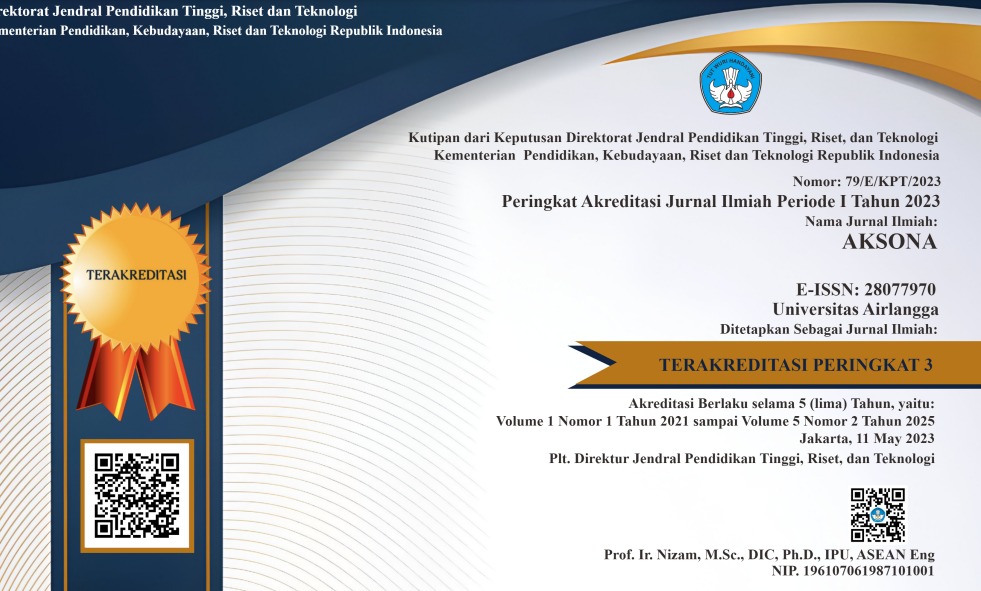Profile of Stroke Patients in John Piet Wanane General Hospital Sorong: A Descriptive Study
Downloads
Highlight:
- Hypertension is the leading risk factor for cardiovascular disease and stroke.
- Blood pressure variability, including early morning surge, increases stroke risk.
- Low education is associated with an increased risk of stroke due to limited health literact and lifestyle challenges.
ABSTRACT
Introduction: Stroke has become the major cause of physical disability in adults and the second leading cause of death in middle- to high-income countries. Indonesia has the second-highest mortality rate and stroke burden in Southeast Asia. Furthermore, there is limited study on stroke in eastern Indonesia, especially in Papua. Objective: This study aimed to evaluate the clinical profile of stroke patients treated in John Piet Wanane General Hospital. Methods: This descriptive, hospital-based study was conducted at John Piet Wanane General Hospital, Sorong, Southwest Papua, from August 1, 2023, to January 31, 2024. Data were collected through interviews and the identification of subjects’ medical records based on inclusion and exclusion criteria. Results: This study involved a total of 143 patients, with an average age of 58.17 ± 10.516 years. The gender distribution was nearly equal, with 52.4% women and 47.6% men. The subjects mainly had an overweight Body Mass Index (BMI) (39,2%) or a normal BMI (36.4%). Obesity and underweight were the least common with percentage of 18.9%% and 5.6% of subjects, respectively. Hypertension (75.5%), prior stroke (33.6%), and hyperlipidemia (33.6%) were the most frequently found among subjects. Diabetes mellitus was found in 29.4% of subects, followed by smoking (28.7%), a history of heart disease (21%), and alcohol consumption (14.7%). Ischemic stroke was the most prevalent type of stroke (65.7%), followed by intracerebral hemorrhage (23,8%), transient ishcemic attack (TIA) (5.6%), subarachnoid hemorrhage (2.8%), and pontine hemorrhage (2.1%). Conclusion:This study revealed that ischemic stroke was the predominant subtype, while pontine hemorrhage was rare. Hypertension emerged as the most common risk factor, followed by prior stroke, hyperlipidemia, and diabetes mellitus, highlighting the substantial burden of modifiable vascular risk factors.
Murphy SJ, Werring DJ. Stroke: Causes and clinical features. Medicine (Baltimore). 2020;48(9):561–6. doi: 10.1016/j.mpmed.2020.06.002
Widyantoro B, Situmorang TD, Turana Y, Barack R, Delliana J, Roesli RMA, et al. May measurement month 2017: an analysis of the blood pressure screening campaign results in Indonesia—South-East Asia and Australasia. Eur Hear J Suppl. 2019;21(Supplement_D):D63–5. doi: 10.1093/eurheartj/suz057
Venketasubramanian N, Yoon BW, Pandian J, Navarro JC. Stroke epidemiology in South, East, and South-East Asia: A review. J Stroke. 2017;19(3):286–94. doi: 10.5853/jos.2017.00234
Kementerian Kesehatan RI. Laporan nasional RISKESDAS 2018. Jakarta: Badan Penelitian dan Pengembangan Kesehatan; 2018. 156 p. [Report]
Parmar P, Krishnamurthi R, Ikram MA, Hofman A, Mirza SS, Varakin Y, et al. The stroke riskometerTM app: Validation of a data collection tool and stroke risk predictor. Int J Stroke. 2015; 10(2):231–44. doi: 10.1111/ijs.12411
Susanto J, Makhfudil, Yusuf A, Ilkafah, Mahardhika A. Characteristics of stroke patients in outpatient: An analytical descriptive. In: The 3rd Joint International Conferences. 2021. p. 7–15. [Conference proceedings]
Widayanti AW, Green JA, Heydon S, Norris P. Health-seeking behavior of people in Indonesia: A narrative review. J Epidemiol Glob Health. 2020; 10(1):6–15. doi: 10.2991/jegh.k.200102.001
Feigin V, Norrving B, Sudlow CLM, Sacco RL. Updated criteria for population-based stroke and transient ischemic attack incidence studies for the 21st century. Stroke. 2018; 49(9):2248–55. doi: 10.1161/STROKEAHA.118.022161
Fekadu G, Chelkeba L, Kebede A. Risk factors, clinical presentations and predictors of stroke among adult patients admitted to stroke unit of Jimma university medical center, south west Ethiopia: Prospective observational study. BMC Neurol. 2019; 19(1):187. doi: 10.1186/s12883-019-1409-0
Arabambi B, Oshinaike O, Akilo OO, Yusuf Y, Ogun SA. Pattern, risk factors, and outcome of acute stroke in a Nigerian University Teaching Hospital. Niger J Med. 2021; 30(3):252–8. doi: 10.4103/NJM.NJM_8_21
Khan FY, Yasin M, Abu-Khattab M, El Hiday AH, Errayes M, Lotf AK, et al. Stroke in Qatar: A first prospective hospital-based study of acute stroke. J Stroke Cerebrovasc Dis. 2008; 17(2):69–78. doi: 10.1016/j.jstrokecerebrovasdis.2007.11.004
Abdu H, Tadese F, Seyoum G. Clinical profiles, comorbidities, and treatment outcomes of stroke in the medical ward of Dessie comprehensive specialized hospital, Northeast Ethiopia; A retrospective study. BMC Neurol. 2022; 22(1):399. doi: 10.1186/s12883-022-02916-7
O’Donnell MJ, Xavier D, Liu L, Zhang H, Chin SL, Rao-Melacini P, et al. Risk factors for ischaemic and intracerebral haemorrhagic stroke in 22 countries (the INTERSTROKE study): A case-control study. Lancet. 2010; 376(9735):112–23. doi: 10.1016/S0140-6736(10)60834-3
Sylaja PN, Pandian JD, Kaul S, Srivastava MVP, Khurana D, Schwamm LH, et al. Ischemic stroke profile, risk factors, and outcomes in India. Stroke. 2018; 49(1):219–22. doi: 10.1161/STROKEAHA.117.018700
Al-Shenqiti AM. Types and risk factors of first time stroke: A Saudi Hospital-based study. Int J Physiother. 2019; 6(4):118–22. doi: 10.15621/ijphy/2019/v6i4/185413
Restikasari NT, Gamayani U, Amalia L, Dian S, Cahyani A. Characteristics and risk factors of patients with acute ischemic stroke in Dr. Hasan Sadikin General Hospital Bandung, Indonesia. Althea Med J. 2022; 9(4):218–22. doi: 10.15850/amj.v9n4.2362
Turana Y, Tengkawan J, Chia YC, Nathaniel M, Wang J, Sukonthasarn A, et al. Hypertension and stroke in Asia: A comprehensive review from HOPE Asia. J Clin Hypertens. 2021; 23(3):513–21. doi: 10.1111/jch.14099
Ekker MS, Verhoeven JI, Schellekens MMI, Boot EM, van Alebeek ME, Brouwers PJAM, et al. Risk factors and causes of ischemic stroke in 1322 young adults. Stroke. 2023; 54(2):439–47. doi: 10.1161/STROKEAHA.122.040524
Setyopranoto I, Bayuangga HF, Panggabean AS, Alifaningdyah S, Lazuardi L, Dewi FST, et al. Prevalence of stroke and associated risk factors in Sleman District of Yogyakarta Special Region, Indonesia. Stroke Res Treat. 2019; 2019(1):1–8. doi: 10.1155/2019/2642458
Alemayehu CM. Assessment of Stoke Patients: Occurrence of unusually high number of haemorrhagic stroke Casesin Tikur Anbessa Specialized Hospital, Addis Ababa, Ethiopia. Clin Med Res. 2013;2(5):94–100. doi: 10.11648/j.cmr.20130205.11
Yesilot Barlas N, Putaala J, Waje‐Andreassen U, Vassilopoulou S, Nardi K, Odier C, et al. Etiology of first‐ever ischaemic stroke in European young adults: the 15 cities young stroke study. Eur J Neurol. 2013; 20(11):1431–9. doi; 10.1111/ene.12228
Petrea RE, Beiser AS, Seshadri S, Kelly-Hayes M, Kase CS, Wolf PA. Gender differences in stroke incidence and poststroke disability in the Framingham Heart Study. Stroke. 2009; 40(4):1032–7. doi: 10.1161/STROKEAHA.108.542894
Boehme AK, Esenwa C, Elkind MSV. Stroke risk factors, genetics, and prevention. Circ Res. 2017; 120(3):472–95. doi: 10.1161/CIRCRESAHA.116.308398
Tang M, Han G, Yao M, Peng B, Zhu Y, Zhou L, et al. Risk factors of ischemic stroke in young adults: A Chinese single-center study. Front Neurol. 2022; 13:874770. doi: 10.3389/fneur.2022.874770
Putaala J. Ischemic stroke in the young: Current perspectives on incidence, risk factors, and cardiovascular prognosis. Eur Stroke J. 2016; 1(1):28–40. doi: 10.1177/2396987316629860
Jan R, Gupta RK, Singh P, Shora T, Hussain S. Risk factors for stroke: A Hospital based descriptive study in North India. Int J Stroke Res. 2015;3(1):1–5. doi: 10.5923.j.stroke.20150301.01
Stevano R, Margono JT, Sutanto A. Clinical profile and risk factors of stroke: A comparative analytical study between young and old onset. Magna Neurol. 2023; 1(1):13–6. doi: 10.20961/magnaneurologica.v1i1.470
Baye M, Hintze A, Gordon-Murer C, Mariscal T, Belay GJ, Gebremariam AA, et al. Stroke characteristics and outcomes of adult patients in Northwest Ethiopia. Front Neurol. 2020; 11. doi: 10.3389/fneur.2020.00428
Diener HC, Hankey GJ. Primary and aecondary prevention of ischemic stroke and cerebral hemorrhage. J Am Coll Cardiol. 2020; 75(15):1804–18. doi: 10.1016/j.jacc.2019.12.072
Copyright (c) 2025 Djohan Ardiansyah, Agustinus Ruma, Lu Jordy Luhur

This work is licensed under a Creative Commons Attribution-ShareAlike 4.0 International License.





















